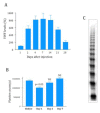Von Willebrand Factor Abnormalities Studied in the Mouse Model: What We Learned about VWF Functions
- PMID: 23936618
- PMCID: PMC3736878
- DOI: 10.4084/MJHID.2013.047
Von Willebrand Factor Abnormalities Studied in the Mouse Model: What We Learned about VWF Functions
Abstract
Up until recently, von Willebrand Factor (VWF) structure-function relationships have only been studied through in vitro approaches. A powerful technique known as hydrodynamic gene transfer, which allows transient expression of a transgene by mouse hepatocytes, has led to an important shift in VWF research. Indeed this approach has now enabled us to transiently express a number of VWF mutants in VWF-deficient mice in order to test the relative importance of specific residues in different aspects of VWF biology and functions in an in vivo setting. As a result, mice reproducing various types of von Willebrand disease have been generated, models that will be useful to test new therapies. This approach also allowed a more precise identification of the importance of VWF interaction with subendothelial collagens and with platelets receptors in hemostasis and thrombosis. The recent advances gathered from these studies as well as the pros and cons of the technique will be reviewed here.
Figures


Similar articles
-
Mouse models to study von Willebrand factor structure-function relationships in vivo.Hamostaseologie. 2009 Jan;29(1):17-8, 20. Hamostaseologie. 2009. PMID: 19151840
-
Biophysical approaches promote advances in the understanding of von Willebrand factor processing and function.Adv Biol Regul. 2017 Jan;63:81-91. doi: 10.1016/j.jbior.2016.09.010. Epub 2016 Sep 28. Adv Biol Regul. 2017. PMID: 27717713 Review.
-
Restoration of plasma von Willebrand factor deficiency is sufficient to correct thrombus formation after gene therapy for severe von Willebrand disease.Arterioscler Thromb Vasc Biol. 2008 Sep;28(9):1621-6. doi: 10.1161/ATVBAHA.108.168369. Epub 2008 Jun 12. Arterioscler Thromb Vasc Biol. 2008. PMID: 18556568
-
Correction of bleeding symptoms in von Willebrand factor-deficient mice by liver-expressed von Willebrand factor mutants.Arterioscler Thromb Vasc Biol. 2008 Mar;28(3):419-24. doi: 10.1161/ATVBAHA.107.159442. Epub 2008 Jan 10. Arterioscler Thromb Vasc Biol. 2008. PMID: 18187670
-
Interaction of the von Willebrand factor with platelets and thrombosis.Recenti Prog Med. 1997 Nov;88(11):526-9. Recenti Prog Med. 1997. PMID: 9401429 Review.
Cited by
-
Angiodysplasia in von Willebrand Disease: Understanding the Clinical and Basic Science.Semin Thromb Hemost. 2017 Sep;43(6):572-580. doi: 10.1055/s-0037-1599145. Epub 2017 May 5. Semin Thromb Hemost. 2017. PMID: 28476066 Free PMC article. Review.
-
The Hepatitis B Virus Pre-Core Protein p22 Activates Wnt Signaling.Cancers (Basel). 2020 May 31;12(6):1435. doi: 10.3390/cancers12061435. Cancers (Basel). 2020. PMID: 32486480 Free PMC article.
References
-
- von Willebrand EA. Hereditär pseudohämofili. Fin Läkäresallsk Handl. 1926;67:7–12.
LinkOut - more resources
Full Text Sources
Other Literature Sources
Research Materials
Miscellaneous
